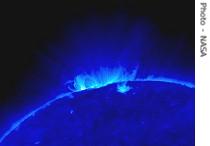2007年VOA标准英语-Two New US Spacecraft Offer Better Warning of S(在线收听)
Washington
01 March 2007
The U.S. space agency NASA says two new spacecraft orbiting Earth are giving scientists an unprecedented ability to track storms on the sun all the way to Earth. As VOA's David McAlary reports from Washington, the satellites will help the government provide the earliest warnings yet of solar blasts than can disrupt electrical systems.
 |
| View of solar flares from two new NASA spacecraft |
These radiation blasts contain billions of tons of electrically charged gas from the sun's atmosphere, or corona, and travel at speeds up to 1.5 million kilometers per hour. When they slam into the more slowly moving cloud of charged particles called the solar wind, they create a shock that accelerates the particles.
This onslaught creates the brilliant auroras at the poles, but can also disrupt power grids on Earth and sensitive electronics in spacecraft, and also harm unshielded astronauts.
The twin spacecraft tracking these blasts, called STEREO-A and STEREO-B, are still heading toward their final optimal viewing orbits, but one mission scientist says their early images of recent solar blasts are exciting.
"This is really the first time we have had such a complete view of this inner heliosphere, this very vast region between the sun and Earth," said Russell Howard of the U.S. Naval Research Laboratory. He says no previous spacecraft watching the sun has had such a sweeping view of the path of solar radiation blasts, which scientists call coronal mass ejections, or CMEs.
"It enables us to track CMEs from their origin at the sun all the way to the orbit of Earth. These images demonstrate the capability and promise of really great things to come," he said.
The twin spacecraft are to lengthen the warning time of the sun's radiation bombardments by providing a stereoscopic view of the particle clouds. Right now, the satellites are separated by only one degree from each other, but they continue widening the gap, and, eventually, will be stationed in Earth orbit 500,000 kilometers apart.
The separation will give depth perception, like our eyes do by being separated in our heads. Mission officials say this will offer a better idea of the direction the solar particle surge is moving and when it will arrive at Earth, allowing the government to warn operators of spacecraft and electrical grids to protect them.
Howard says even the early views with the two spacecraft still close together have provided new information about the shape and speed of coronal mass ejection clouds.
"This panoramic view is absolutely unique. So, even though we are not seeing the CMEs necessarily the best way coming toward Earth, the way we will when there is some separation, we are still seeing the evolution of this material as it goes out into interplanetary space, and we are already seeing that interaction with the solar wind. So, it is quite useful," he said.
The STEREO mission is to last two years.